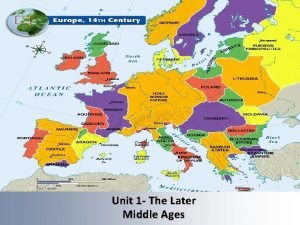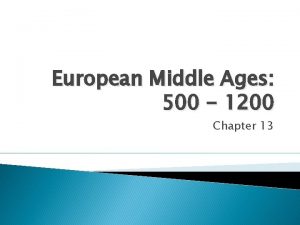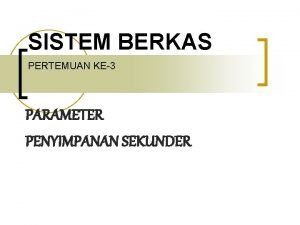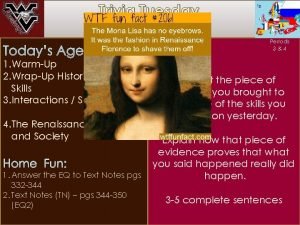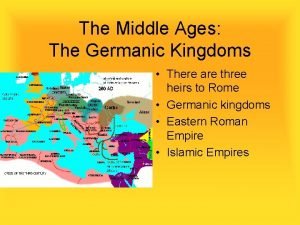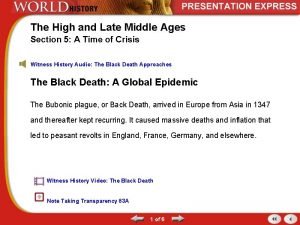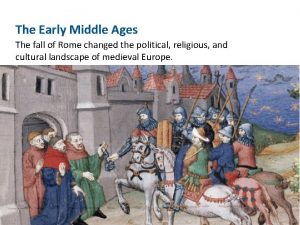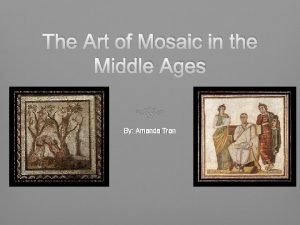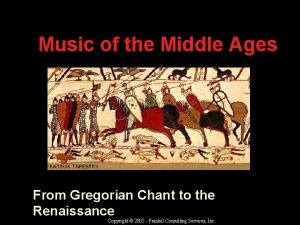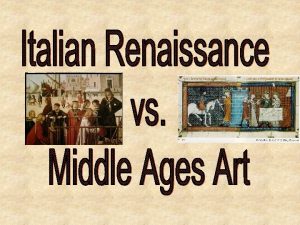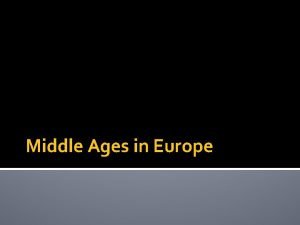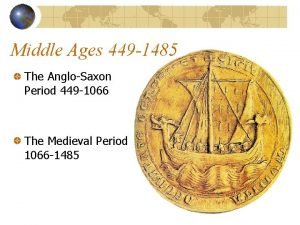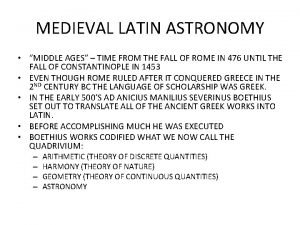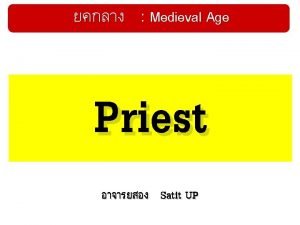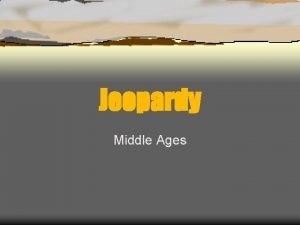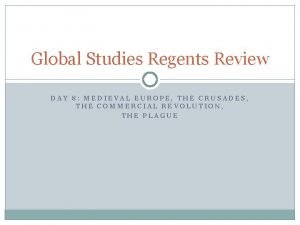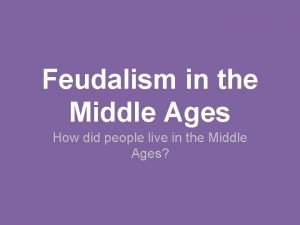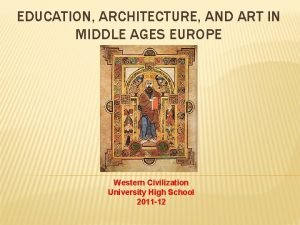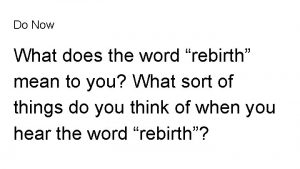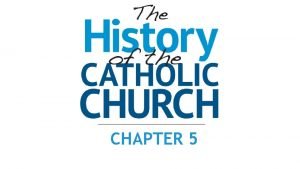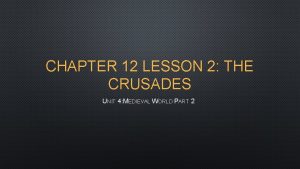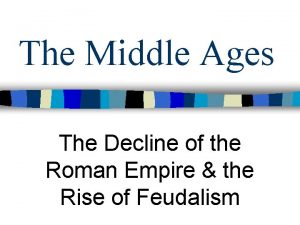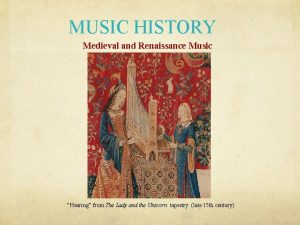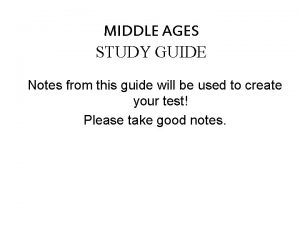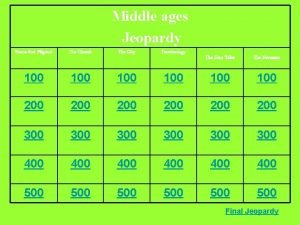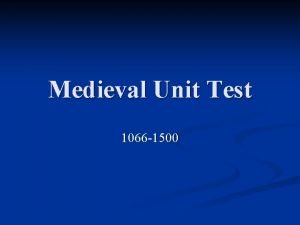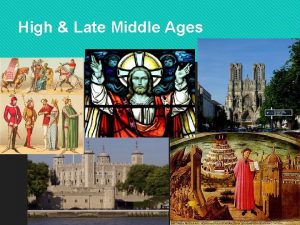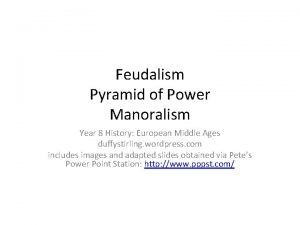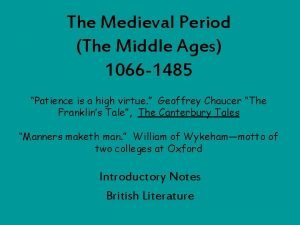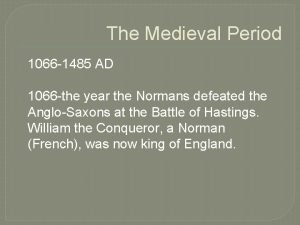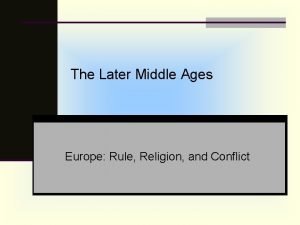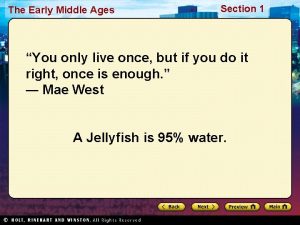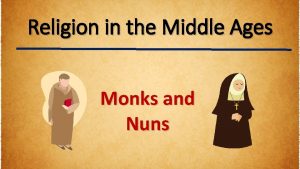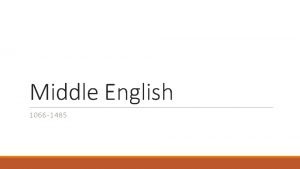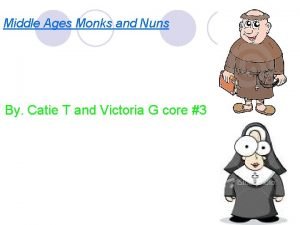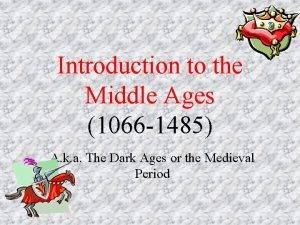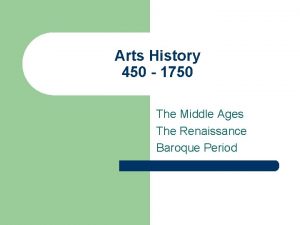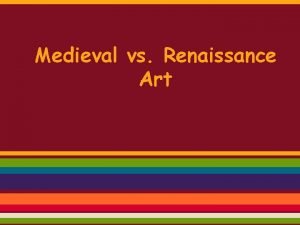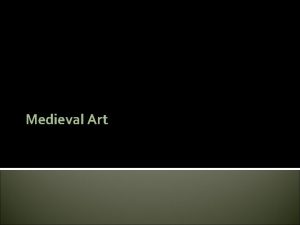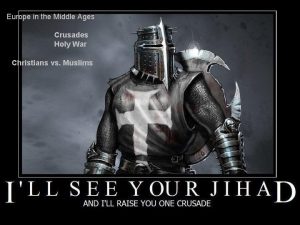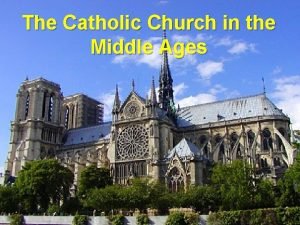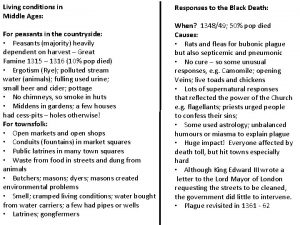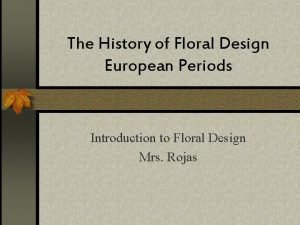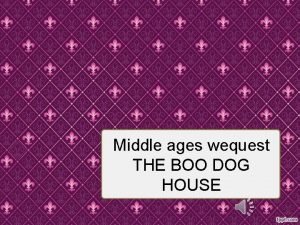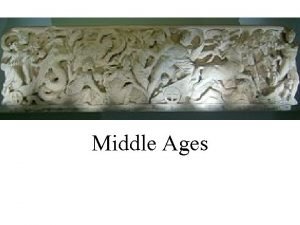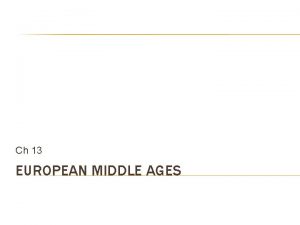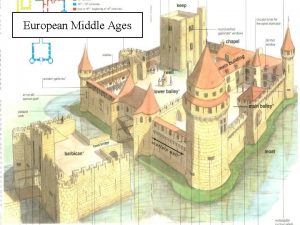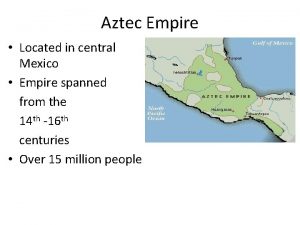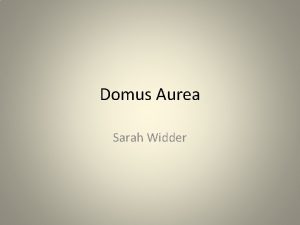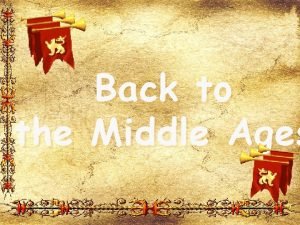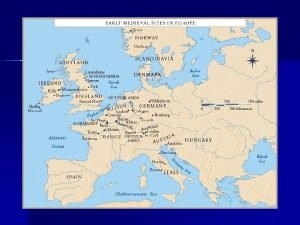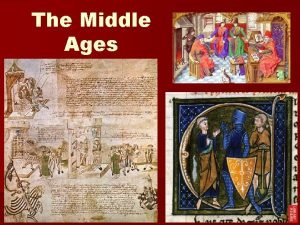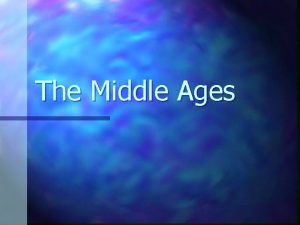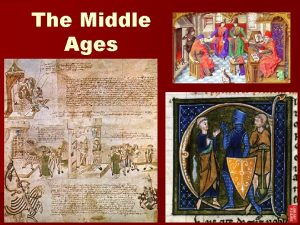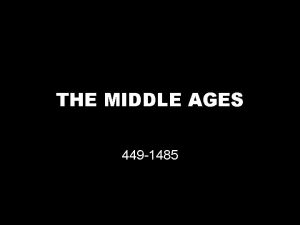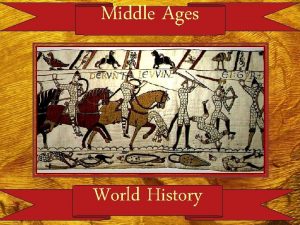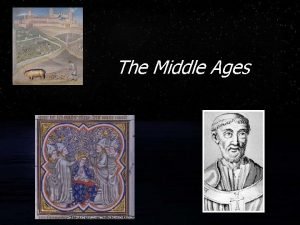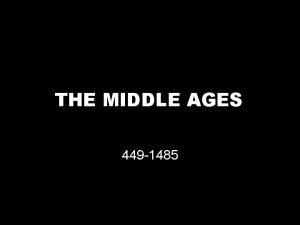European Middle Ages Day 1 Middle Ages Spanned





























































- Slides: 61

European Middle Ages

Day 1

Middle Ages �Spanned from 500 -1500

Why are we learning this? �Christianity is still the dominant religion in European immigrants and their descendants have made Christianity the dominant religion in North and South America �Today’s forms of representative government include mutual rights and responsibilities, as feudalism did �Religious leader still speak out of political issues such as war and poverty

Germans Invade Former Western Rome �German forces invaded what had been the Western Roman Empire �Germans brought about a lot of change �Disruption of Trade �Downfall of Cities �Population Shift �Decline of Learning �Loss of Common Language

Disruption of Trade �Merchants were facing invasion from both land sea �Attackers were coming both on foot and ship �Created a problem from selling goods �No one wants to buy goods in the middle of a battle �Businesses collapsed �Breakdown of trade destroyed Europe’s cities as economic centers �Money transactions did not happen thus making money scarce

Downfall of Cities �People abandoned cities to try and escape the fighting �No one wants to live where fighting is taking place �People would move out of cities and not come back

Population Shifts �Because of the cities and governments collapsing, nobles retreated to the rural areas �Roman cities were left without strong leadership �Other city dwellers also fled to the countryside �Grew their own food, lived off of the land �Population became mostly rural

Decline of Learning �The German invaders could not read or write �People were displaced from the city to the countryside where there wasn’t any schools or libraries �Few people except priests and other church officials were literate �The knowledge attained about Greek and Roman culture was almost completely lost �Only a few people could read Greek works of literature, science and philosophy

Loss of a Common Language �With German people mixing with the Roman population, Latin changed �It was still the official language, but no one really understood it �Different dialects were developed as new words and phrases �Became part of everyday speech �By the 800’s French, Spanish, and other Roman- based languages had evolved from Latin �Eventually two different languages were formed: French and Spanish

Government 400 - 600 �Small Germanic kingdoms replaced Roman provinces �Borders of those kingdoms changed all the time with the fortunes of war �Countries would take land over, lose it, take it over again �Throughout everything going on, the Church as an institution survived the fall of the Roman Empire �During the time of chaos, the Church provided order and security �Small communities governed by unwritten rules and traditions were created

Government 400 - 600 �The concept of Government changes �Loyalty to public government and written law had unified Roman society �Family ties and personal loyalty, rather than citizenship in a public state, held Germanic society together

Germanic Leaders and Follower Relationship �Every Germanic chief led a band of warriors who had pledged their loyalty, rather than citizenship to him �People had personal relationships with their chief �The chief gave his people food, weapons, and treasure �In battle, warriors fought to the death at their lord's side �They considered it a disgrace to outlive him �Citizens felt no loyalty to an emperor because they never met �Wouldn’t respect any official who was sent to collect taxes on behave of the emperor

Franks and Christianity �Franks: a Germanic people who settled in the Roman province of Gaul and established a great empire during the Middle Ages �Frank Leader: Clovis brought Christianity to his people �While in a losing battle, Clovis turned to the Christian God for help �The battle shifted and the Franks won �The Church in Rome supported Clovis’s military campaigns against other Germanic peoples �In 511, Franks were united into on Kingdom (modern day France)

Germans Adopt Christianity �Politics played a key role in spreading Christianity � By 600, the Church and Frankish rulers, many Germanic people were converted to Christianity

Missionaries �Religious travelers �Often risked their lives to bring religious beliefs to other lands �Goal was to spread their religion �We are talking about Christianity

Monasteries �Monastery: a religious community of men (called monks) who have given up their possessions to devote themselves to a life of prayer and worship �These were built to adapt of rural conditions �Women who followed this way were called nuns and lived in convents �Importance of education is a major focus �Helps to keep learning and education alive during the Middle Ages

Monasteries �Benedict �Monk, wrote a book describing the rules for monastic life �These guidelines became a model for many other religious communities in western Europe �Became Europe’s best educated communities �Many monks opened up schools, maintained libraries, and copied books �Scholars consider monasteries the best historical work of the early Middle Ages

Pope Gregory I/ Gregory the Great �Expanded the authority of the papacy (pope’s office) �Traditionally the pope just played a spiritual role �Secular (worldly) power – involved in politics �The pope’s palace was the center of the Roman government �Used Church revenue to raise armies, repair roads, and help the poor �Negotiated peace treaties with invaders such as the Lombards �Strengthened the vision of Christendom �Church kingdom that fanned out from Rome to the

Charles Martel (Charles the Hammer) �Mayor of the palace �Held more power than the king �Extended the Frankish kingdom to the north, south, and east �Battle of Tours �Stopped the Muslim Invasion �If the Muslims would have won, western Europe might have become part of the Muslim Empire �His victory at tours made him a Christian hero �His son, Pepin the Short, was his successor

Pepin the Short �Became King when his father passed away �Agreed to work with the pope �Fought the Lombards in agreement with the pope �Lombards were invading Italy and threatening Rome �In exchange for fighting the Lombards, the pope made Pepin “king by the grace of God” �Became the first king ever anointed by the pope �This began the Carolingian Dynasty �Ruled the Franks from 751 to 987

Charlemagne �Also known as Charles the Great �Ruled the kingdom after his Father and brother died �Wanted to expand the empire and Christianity

Charlemagne the Roman Emperor �Built an empire grater than any know since ancient Rome �Led armies to battle the enemies surrounding the Frankish Empire �Reunited Western Roman empire �First time since the Roman empire �Protected the Pope so became known as the Roman Emperor

Charlemagne’s Empire �Limited the authority of the nobles �Sent out royal agents to make sure the nobles were governing their counties justly �They made sure that the powerful landholders (counts) governed their kingdoms correctly and weren't corrupt �Charlemagne regularly visited every part of his kingdom �Encouraged learning �Surrounded himself with German, English, and Spanish scholars �Monasteries opened schools and expanded their libraries

Downfall of Charlemagne’s Empire �A year before Charlemagne died, he crowned his son, Louis the Pious, as emperor �Louis was very religious but not a very good ruler �Louis left his three sons the empire �All who split the empire up �All signed the Treaty of Verdun which divided the empires into three kingdoms �Without central authority or strong leadership the empire weakens

Feudalism �A political system and economic system based on land ownership and personal loyalty

Day 2

Vikings �Came from Scandinavia, a Germanic people �Also known as Northmen or Norsemen �They worshiped warlike gods and took pride in nicknames �Eric Bloodaxe and Thorfinn Skullsplitter �Were able to attack and get away quickly �They would raid a ship or port, steal and kill, then quickly move out to sea before locals could mount a defense �Known for their ability to sail, trade, and raid

Viking Warriors �May have reached the Americas around 1000 �This is almost 500 years before Columbus �Leif Ericson led the voyage �Gradually started to accept Christianity �This stopped them from raiding monasteries �Started to adopt agricultural practices

Invasions throughout Europe �Magyars attacked from the East �After taking over land, they did not settle, capture people as slaves �Muslims attached from the South �Their plan was to conquer and settle in Europe �Were very good at attacking settlements on the Atlantic and Mediterranean coasts �Vikings attacked from the North

Vikings v. France �Rollo – head of the Viking army �Charles the Simple – King of France �Charles gave the Vikings a piece of land – Normandy in return for Rollo ending his plundering of French land

Feudalism: Mutual Obligation �Lord: Landowner given in exchange for military service and loyalty to the king �Fief: grant of land �Knights: mounted warriors served Nobles/Lords �Peasants: those who worked the land owned by their Lord �Serfs: people who could not legally leave the land

European Feudal System

Manors �Manors: lords estate �There was an agreement between the lords and serfs that lived at the manor �The lord provided the serfs with housing, farmland, and protection from bandits �The serfs tended the lord's lands, cared for his animals, and performed other tasks to maintain the estate �Peasant women shared in the farm work with their husbands

Manors � Only a few square miles � Contained 15 – 30 families � Typical manors included: �Manor House: the dwelling place of the lord and his family and their servants �Village Church: Site of both religious services and public meetings �Peasant Cottages: Where the peasants lived �Lord’s Demesne: Fields owned by the lord and worked by the peasants �Peasant Crofts: Gardens that belonged to the peasants �Mills: Water-powered for grinding grain �Common Pastures: Common area for grazing animals �Woodland: forests provided wood for fuel

Feudal Manor

Peasant Life �Paid taxes on grain ground in the lord’s mill �Paid taxes on marriage �Weddings had to be approved �Paid a tithe �A 10% tax given to the church

Day 3

Chivalry �Chivalry: a code of behavior for knights in medieval Europe, stressing ideals such as courage, loyalty, and devotion �Ideals that governed European warfare �Demanded that a knight fight bravely in defense of three masters �Feudal lord �God �Chosen lady (his love)

Knights/Soldiers �Heavily armored �Armored themselves to protect from arrows and swords �Try to cover every part of the body �Well trained �Sword training and horseback riding �Fought on horseback �Leather saddles and the use of stirrups for balance �Was able to carry heavy weapons because of the stirrups �Most important part of an army

Knights Defend �Europe was a battle ground between nobles �All were trying to fight for power throughout the lands �Feudal lords raised private armies of knights to protect their lands �In exchange for military service, feudal lords used their most abundant resource (land) to give to the knights and most skilled warriors �Fiefs: pieces of land given out to the knights and skilled warriors �A lord would typically require knights to give 40 days of service

Knights �Chivalrous knights protected the weak and poor �The ideal knight was loyal and brave �Those that failed to meet these high standards: �Stripped of their armor �Shield was cracked �Spurs were cut off �Sword was broken over his head �Thrown into a coffin and suffered through a mock funeral

Knights and Battles �Castles �Home of the lord, lady, family, knights, and servants �Fortress �Ways to defend the castle: �Boiling water, oil, or molted lead �Archers on the roof

Castle and Siege Weapons �Siege Tower �Had a platform on top that lowed like a drawbridge �Could support weapons and soldiers �Mantlet �Shielded soldiers �Batterling Ram �Made of heavy timber with a sharp metal tip �Swung like a pendulum to crack castle walls or to knock down a drawbridge

Castle and Siege Weapons �Tortoise �Moved slowly on wheels �Sheltered soldiers from falling arrows �Mangonel �Flung huge rocks that crashed into castle walls �Propelled objects up to a distance of 1, 300 feet �Trebuchet �Worked like a giant slingshot �Propelled objects up to a distance of 980 feet

Tournaments �Mock battles between a group of knights �Knights would try to prove their battle skills in front of an audience �Winners usually demanded some kind of ransom from defeated knights

Medieval Women �During this time period many of the men were powerless �This was even tougher for women since they were already seen as being inferior to men �Role became increasingly limited to homes and convents �This was backed by the church �Noblewomen held some power and played key roles in their estates �They could inherit land from their husbands and send his knights to war �Helped in defending the castle by firing arrows and hurling rocks

Troubadours �Poet-musicians �Worked at castles and courts throughout Europe �Composed short verses and songs about joy, love, and sorrows

Day 4

Literature of Chivalry �Idealized castle life �Made living in the castle sound great �Glorified knighthood, tournaments, and battles �Songs and poems about a knights love for his lady �Example of a medieval epic story: �The Song of Roland

The Power of the Church �Since there was a weak central government in feudal Europe, the Church was able to emerge as a powerful institution �After the crowning of Charlemagne as the Roman Emperor in 800, the Church sought to influence both spiritual and political matters �Pope Gelasius recognized 300 years earlier that a conflict could arise between Church and Kings �“There are two powers by which this world is chiefly ruled: the sacred authority of the priesthood and the authority of kings”

Structure of the Church �Power based on status �Pope: head of the Catholic Church �Clergy: religious officials consisting of bishops, priests, and various members of the Church �Bishops: supervised priests, settled disputes over church teachings and religious practice �Priests: local church leaders

Unification of Religion �Shared beliefs in the teaching of the church brought people together �The church was a stable force during an era of constant warfare and political turmoil �Provided a sense of security and religious community �Sacraments: important religious ceremonies performed for the common people �Examples: baptism

Church Laws �Cannon Law: the body of laws governing the religious practices of a Christian church �Church courts tried people who violated these laws �Harshest Punishments: excommunication and probation �Excommunication: banishment from the church �Popes would use threat of excommunication against political rulers as a way of getting what they wanted

Holy Roman Empire �Otto the Great (Otto I) was crowned king in 936 �Followed the policies of his hero, Charlemagne �Created a close alliance with the Church �Limited the power of the nobles with increased power to the clergy �Would gain the support of people to build up his power

Holy Roman Empire v. the Pope �Lay Investiture: a ceremony in which kings and nobles appointed church officials �This did not make the church happy �The church wanted to pick their own officials �The church knew that whoever controlled Lay Investiture held the real power in naming bishops, who were very influential clergy that kings sought to control �It wasn’t until 1075 that Lay Investiture was banned

Canossa, Italy �German Emperor Henry IV �Called the Pope a “false monk” �Pope excommunicated Henry, started losing control of Germany �Went to beg the Pope forgiveness �The Pope made Henry wait in the snow for 3 days before lifting the excommunication (The Pope was obligated to forgive any sinner who begged so humbly)

Concordat of Worms �Says that the church alone could grant a bishop his ring and staff, symbols of the church office �The Emperor had the right to veto (or prevent) the appointment of a bishop

Frederick I/Barbarossa �In 1152, seven German Princes realized that Germany needed a strong ruler to keep the peace �They elected Frederick I, nickname was Barbarossa �First ruler to call his lands the Holy Roman Empire �His forceful personality and military skills enabled him to dominate the German princes �Focused on invasion of rich cities in Italy �His brutal tactics spurred Italian merchants to unit against him

Lombard League �Italian merchants and the Pope united to fight Frederick � 1176 foot soldiers battled Frederick’s mounted knights and won �This was a very surprising victory, it proved that foot soldiers could beat knights �Italian foot soldiers used crossbows to defeat feudal knights for the first time in history

German Bickering �Frederick I empire dissolved into fragmented feudal states �Disunity weakened the nation �Territories would attack each other
 Day 1 day 2 day 3 day 4
Day 1 day 2 day 3 day 4 Dark ages def
Dark ages def Renaissance art vs medieval art
Renaissance art vs medieval art European middle ages map
European middle ages map 500
500 Day 1 day 2 day 817
Day 1 day 2 day 817 Her life spanned years of incredible change
Her life spanned years of incredible change Spanned volume
Spanned volume Image formation model in digital image processing ppt
Image formation model in digital image processing ppt Unspanned blocking
Unspanned blocking Dark ages vs renaissance
Dark ages vs renaissance Germanic kingdoms in the middle ages
Germanic kingdoms in the middle ages Ancient greek floral design
Ancient greek floral design The high and late middle ages section 5 quiz
The high and late middle ages section 5 quiz Early middle ages
Early middle ages Medieval period mosaic
Medieval period mosaic Late middle ages timeline
Late middle ages timeline Gregorian chant composers
Gregorian chant composers Dark ages vs renaissance
Dark ages vs renaissance Manor system def
Manor system def Middle ages description
Middle ages description Astronomy in medieval times
Astronomy in medieval times Clergy ranks
Clergy ranks Middle ages jeopardy
Middle ages jeopardy What were two indirect results of the crusades
What were two indirect results of the crusades Feudal system in the middle ages
Feudal system in the middle ages Cathedral art
Cathedral art What word means rebirth
What word means rebirth Similarities between middle ages and renaissance
Similarities between middle ages and renaissance Middle ages def
Middle ages def Lesson 2 the crusades
Lesson 2 the crusades Arts in emerging europe
Arts in emerging europe Middle ages
Middle ages The middle ages spans nearly one thousand years.
The middle ages spans nearly one thousand years. Middle ages study guide answer key
Middle ages study guide answer key Language answer
Language answer Middle ages unit test answers
Middle ages unit test answers Art nouveau period floral design
Art nouveau period floral design High to late middle ages
High to late middle ages Feudal pyramid.
Feudal pyramid. The middle ages outcome the power of the church
The middle ages outcome the power of the church Middle ages 1066 to 1485
Middle ages 1066 to 1485 The middle ages 1066 to 1485: unit test
The middle ages 1066 to 1485: unit test Early middle ages
Early middle ages Middle ages nobles
Middle ages nobles Sacred music of the middle ages
Sacred music of the middle ages Monks and nuns in the middle ages
Monks and nuns in the middle ages The middle ages 1066 to 1485 unit introduction
The middle ages 1066 to 1485 unit introduction Monks and nuns middle ages
Monks and nuns middle ages The middle ages 1066 to 1485 unit test closed book
The middle ages 1066 to 1485 unit test closed book 450/1750
450/1750 Middle ages
Middle ages Medieval art vs. renaissance art
Medieval art vs. renaissance art Characteristic of medieval art
Characteristic of medieval art Middle ages
Middle ages How is this
How is this Naissance renaissance
Naissance renaissance High middle ages
High middle ages Middle ages
Middle ages Living conditions in the middle ages
Living conditions in the middle ages European floral design history
European floral design history Around 900 ce a new form of government called
Around 900 ce a new form of government called



